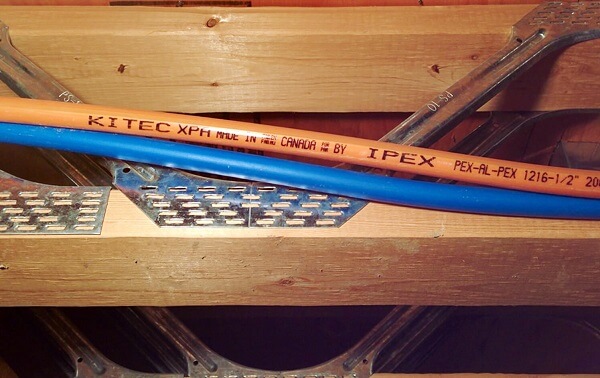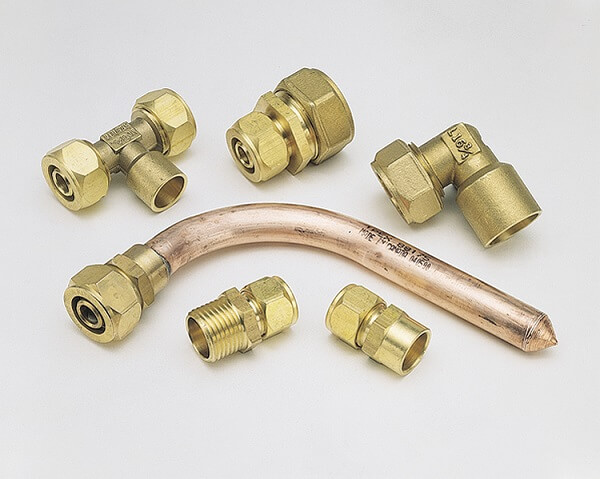Kitec plumbing defects and maintenance
The three most common issues with Kitec plumbing are:
- It can’t take the heat. The orange pipes were only certified to run at a maximum temperature of 82 degrees Celsius, but hot water tanks can run hotter than this. The higher heat causes the pipes to deteriorate.
- It deteriorates under pressure. High water pressure can cause these pipes to fail.
- It’s prone to blockages. Kitec plumbing fittings are made of brass, an alloy of copper and zinc. When zinc is exposed to oxygen and moisture, it corrodes, creating zinc oxide (a process known as dezincification). Zinc oxide forms blockages in the pipes that restrict water flow and increase the risk of a breakage.
One of the problems with Kitec plumbing is that the pipes won’t just leak — they’re likely to burst. Sudden pipe bursts in a home can cause thousands of dollars in water damage.
Some plumbing experts say the question is not if your Kitec plumbing will leak, but when it will leak. If you have Kitec plumbing in your home, consider calling in a licensed plumber or certified home inspector to take a look. A qualified plumber might determine that your Kitec pipes aren’t under pressure and aren’t carrying overly hot water, and thus stand a better chance of surviving without issue.
Unfortunately, rare is the home plumbing system that doesn’t carry hot water. It doesn’t appear as though there are any actions a homeowner can take to prevent Kitec pipes from rupturing. In the long term, the only solution is to replace the entire system.
Kitec plumbing replacement cost
The cost of replacing Kitec plumbing varies widely depending on the size of the home, how easy the pipes are to access, and a host of other factors. Replacement cost estimates range from $5,000–$15,000. The cost may grow even higher if it’s necessary to remove a lot of flooring or wall coverings to access the plumbing.
Kitec plumbing class action lawsuit and recalls
Kitec’s manufacturer recalled the plumbing in 2005. In 2011, courts in Quebec, Ontario, and the US approved a settlement agreement in a class action lawsuit, and homeowners who suffered Kitec plumbing leaks could receive a share of the $125 million USD settlement.
Claim submissions for this case officially ended on January 9, 2020. However, the administrator is still processing claims and a final distribution plan for the settlement funds is still in progress. Presently, only those who experienced actual failure of their systems are eligible for compensation, but anyone who has Kitec plumbing in their home was encouraged to file a claim.
If you have Kitec plumbing and you didn’t file a claim under the class action settlement, it may not be too late. You’re encouraged to keep checking the settlement administrator’s website as the settlement process continues. According to the latest update, hearings took place in Texas courts in June 2023 regarding the final allocation of settlement funds. Upon the resolution of those hearings, similar hearings will take place in Ontario and Quebec regarding the Canadian portion of the settlement.
Kitec plumbing home insurance considerations
Home insurance providers do want to know what kind of plumbing you have in your home. If your plumbing is of a problematic variety — like Kitec or Poly-B — they may refuse to insure your home. Or, they may insure your home under special conditions; they could increase your deductible or decline to cover losses caused by a malfunction in your plumbing system.
In any case, you need to disclose Kitec plumbing if an insurance application asks about it. Lying on an insurance application is grounds for a void policy.
Square One can insure most homes that have Kitec plumbing, particularly if the system has no history of leaking. However, a higher deductible will apply to any losses resulting from the Kitec system. If you ever replace the Kitec system, the special deductible will go away.
Home insurance and damage from burst pipes
Typically, home insurance policies include coverage for any sudden or accidental escape of water in your home, including ruptured water lines, or overflowing appliances. The keys are sudden and accidental escape of water. When a pipe suddenly bursts, home insurance would typically cover the resulting damage. If, however, the pipe had a gradual leak that caused serious water damage over a long period of time, most policies would not cover it. It’s the homeowner’s responsibility to stay on top of maintenance issues like leaky pipes.
In any case, that’s why insurance companies ask what type of plumbing you have in your home. They need to accurately assess the risk to charge the right rates and provide you with the right coverage — the presence of Kitec plumbing means a higher risk of sudden pipe bursts. Sometimes, a company may not be able to insure you at all, and you’ll need to shop around — and likely pay a higher rate — if you can find coverage at all. Don’t let this tempt you to lie to your insurance broker. Such misrepresentation can void your policy when it’s discovered. Always tell the truth! If you discover that the only solution is to replace your plumbing, the expense will be a lot less than finding out, after a loss, that you have no insurance coverage.
When you have a policy in place, remember that there are always exclusions and limitations. Always read your policy wording, with an emphasis on any water exclusions. You can contact your insurance agent or broker if you have any questions. In most cases, there is a requirement that you either shut off your main water supply, or arrange to have your home checked daily, if you are going to be away more than a few days during the winter.
If you fail to do this, damage caused by frozen or burst plumbing may not be covered. The requirements differ from one company to the next, so before you go away on vacation, give your insurance provider a call to make sure you know what’s expected of you.
Commonly asked questions
How much does it cost to replace Kitec plumbing?
It will cost between $5,000 and $15,000 to replace a Kitec plumbing system, plus additional costs based on how badly the floors and walls need to be ripped open during the process. The cost to replace Kitec plumbing depends largely on the size of the home, and how much of its plumbing system are Kitec components.
Should you buy a house with Kitec plumbing?
If you’re in the market for a new home, Kitec plumbing shouldn’t be a dealbreaker on an otherwise suitable option. Instead, the presence of a Kitec plumbing system would be a bargaining chip. For example, you might get a cost estimate for replacing the system and deduct that cost from your offer. Either way, if you’re looking at buying a home with Kitec in it, you should have a plan to address the issue before you make an offer.
Is Kitec plumbing the same as PEX?
PEX is an abbreviation of cross-linked polyethylene, a type of plastic often used to make pipes. Kitec plumbing is made from layers of aluminum and PEX sandwiched together, but there are other forms of PEX plumbing that are perfectly acceptable for modern homes. To put it one way, all Kitec pipes contain PEX, but not all PEX pipes are Kitec.
Do you have to disclose Kitec plumbing when selling a condo or home?
When you’re selling your home, you have a duty to disclose any material defects. Since Kitec plumbing is known to be defective (and the manufacturer recalled it), having such a system in your home can certainly be considered a material defect. Accordingly, you should absolutely disclose Kitec plumbing when you’re selling your home. It would be uncovered during potential buyers’ inspections anyway.
What is the life expectancy of Kitec plumbing?
Kitec pipes were used in homes starting in 1995. The first fitting recalls occurred in 2005. Accordingly, we can estimate the life expectancy to be around 10 years. Given that the last Kitec systems were installed around 2007, all Kitec systems are now well past this estimated lifespan.
Want to learn more? Visit our Getting to Know Your Home resource centre for the complete rundown on all your home's systems and features. Or, get an online quote in under 5 minutes and find out how affordable personalized home insurance can be.





